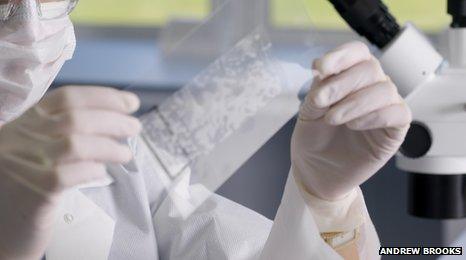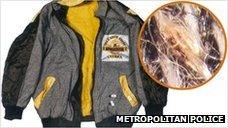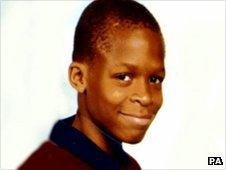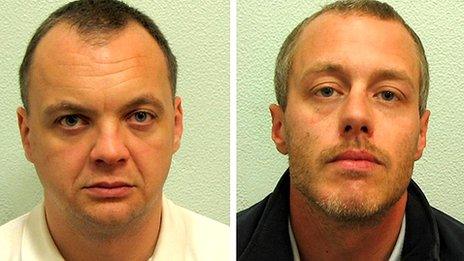How forensics 'solved' Stephen Lawrence murder
- Published

The murderers of Stephen Lawrence were convicted on the strength of fresh forensic evidence following a "cold case review" that started in 2006.
Scientists working at LGC Forensics in the UK found clothing fibres and hair from the teenager on the clothes of the two killers, Gary Dobson and David Norris.
A key breakthrough was the discovery of a microscopic speck of Stephen's blood on Dobson's jacket.
How did the forensic experts 'crack' the case?
They examined clothing recovered at the time of the murder in 1993 to see if anything had been missed and whether new techniques could help.
They found fragments from Stephen's red polo shirt had unexpectedly transferred onto his jacket.

The 0.5mm blood stain was found using 40 times magnification
The scientists then went over the original sticky tape samples from the suspects' clothes and found the same red fibres on Gary Dobson's jacket and David Norris's sweatshirt.
At the time of the original investigation, experts believed evidence like this would have fallen off during the two week gap between the attack and the first arrests.
Scientists at LGC found more fibres and also human hairs on other tapings from the suspects' clothes.
The hair found on David Norris's jeans matched Stephen's DNA profile.
The first sign of blood came when scientists used an instrument called a microspectrophotometer to detect the colour of one of the fibres on Dobson's jacket.
They decided to go over the rest of the jacket with a microscope, magnifying it 40 times.

Edward Jarman: New methods meant the blood speck could be analysed
A spot of blood 0.5mm x 0.25mm was found soaked into the collar - it also matched Stephen's DNA.
In the past, DNA testing on such tiny samples of blood and hairs was not possible so forensic experts wouldn't normally have looked for them in the first place.
But new forensic techniques developed since 2000 helped LGC bag the vital evidence and counter claims that the clothing could have been contaminated.
"The DNA that was available as part of the initial investigation - back in the 90's - they wouldn't have been able to analyse that microscopic stain," says Edward Jarman, Lead Scientist at LGC Forensics.
"But the profiling techniques we have available now are sensitive enough."
What else do the LGC Forensic specialists do?
The company has 500 staff across eight laboratories in the UK and it's also worked with police on high profile cases like the killing of Damilola Taylor, and the 1992 murder of Rachel Nickell on Wimbledon Common.

LGC also helped provide evidence in the Damilola Taylor case
In the Taylor case, the scientists again re-examined the suspects' clothing and found blood and fibres from the 10-year-old on his attackers' clothing.
Their work helped finally convict two brothers, Ricky and Danny Preddie, of manslaughter.
It also worked on the Joanna Yeates case, helping enhance the weak DNA samples found with her body and link the murder to Vincent Tabak.
As well as laboratory work, LGC also has a 'call out' service for crime scenes; firearms specialists who can help identify weapons and ammunition; and a digital forensics team who help gather evidence from devices like computers and phones.
During the Milly Dowler investigation it helped Surrey Police analyse CCTV footage and pinpoint when and where the schoolgirl disappeared, as well as identifying the car driven by her murderer Levi Bellfield.
- Published4 January 2012
